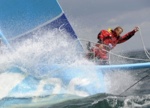A long-distance race like the Vendée Globe is not won purely by luck or small details. It is crucial to develop a strategy to catch the best winds and choose the most advantageous direction. Therefore, setting sail and hoping for help from Aeolus, the God of the wind, is simply not possible. Jean-Pierre Dick understands this well and dedicates a lot of time to his work: “I organize my race strategy based on the data from weather files. I have scheduled work sessions according to the times when weather data is received. They are updated four times a day. So, I usually spend time in the morning and early afternoon, keeping an eye on any significant changes between updates. On average, I spend four hours a day at the chart table. That’s the norm. It can vary depending on whether the wind conditions require more presence on deck or not.”
A presence that was more than necessary last Thursday for the skipper from the French Riviera. It was essential to prepare for the light winds accompanying the St. Helena High. An exhausting time, as he recounted on Friday the 28th: “Not easy at the moment: the wind changes, weakens, strengthens… I tried to refocus last night: not great for the rankings, but we’re all in a group. It all hangs by a thread, so you shouldn’t get too caught up in the hierarchy. Last night, I had a frustration fit while tacking: couldn’t sleep! Annoying. Now, I see Vincent (Riou) and Roland (Jourdain), two long-time competitors: it feels like a two-day regatta, pacing each other… It changes, it gives benchmarks, it’s useful to see others. The boat’s doing well: 10.7 knots, but in two days, brrr, it’s going to get cold!”
Jean-Pierre Dick is resilient and well-prepared. He must be able to react quickly in case of sudden changes in weather conditions: “The important thing is to set a strategy for two or even three days and not just look at the daily rankings. You need to position yourself well concerning the arrival of weather phenomena. But since forecasts aren’t always accurate, adjustments need to be made based on sea observations to deduce the most probable evolution. If everything went as planned, we would all be at the same place!”
While the entire fleet will find itself in Les Sables d’Olonne in a few weeks, for now, they are taking quite different paths, as noted by the Nice native on Saturday: “I occasionally sleep outside in my red seat to be more responsive. It’s not very restful, but I’m not sure this race will ever be (laughs)! The weather is really complicated. Should I take the direct route like Jean Le Cam at the risk of getting too close to the center of the high, or should I go around like Loïck Peyron and increase the distance? I prefer going slower and taking a middle route.”
A decision that seems to be paying off as he returns among the frontrunners. In any case, the boat is performing well, and Jean-Pierre Dick seems to be in a consistently excellent mood—a good sign for what’s to come, as he explained yesterday: “I’m good but a little tired. The conditions aren’t easy for sleeping. There are sudden wind gusts that require a lot of vigilance. Yesterday (Tuesday, note), it was intense! I decided to push harder because I felt fit. The crucial moment was last night (the previous night, note) when I had to gybe. I ate and took a short nap before the maneuver, and it went really well. I’m aiming for the ice gate, which I’ll reach tomorrow (today, note). This morning (Yesterday morning, note), I’ll rest in short periods because the wind is steady at 25 knots (about 46 km/h, note).”
Now heading east, towards the first cape on the course, the Nice skipper will try to stay among the leaders before reaching the Kerguelen Islands in the Indian Ocean, which will be the next obstacle on the fleet’s route.


